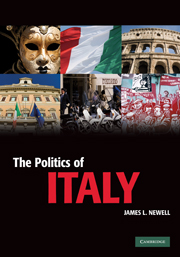Book contents
- Frontmatter
- Contents
- List of figures
- List of maps
- List of tables
- List of boxes
- Acknowledgements
- List of abbreviations
- Chronology
- Map 1 Italian regions and major cities
- Introduction
- I Historical background
- II The polity: structures and institutions of the regime
- 2 The constitutional framework
- 3 Multi-level government
- 4 Policy-making and policy implementation: executives, legislatures and bureaucrats
- III Politics: citizens, elites and interest mediation
- IV Policies and performances
- Appendix: The electoral system for the Chamber of Deputies and the Senate
- References
- Index
4 - Policy-making and policy implementation: executives, legislatures and bureaucrats
Published online by Cambridge University Press: 05 August 2012
- Frontmatter
- Contents
- List of figures
- List of maps
- List of tables
- List of boxes
- Acknowledgements
- List of abbreviations
- Chronology
- Map 1 Italian regions and major cities
- Introduction
- I Historical background
- II The polity: structures and institutions of the regime
- 2 The constitutional framework
- 3 Multi-level government
- 4 Policy-making and policy implementation: executives, legislatures and bureaucrats
- III Politics: citizens, elites and interest mediation
- IV Policies and performances
- Appendix: The electoral system for the Chamber of Deputies and the Senate
- References
- Index
Summary
Introduction
The purpose of this chapter is to explore
(1) how, in the process of policy-making, the legislature, the political executive and the bureaucracy interact in the Italian case, and
(2) how power (Box 4.1) to influence the content of policy is distributed between them.
Political scientists usually think of legislatures as being the least influential of the three types of institution. As we shall see, Italy is a somewhat unusual case in this respect.
Largely because of the scope and complexity of modern government in mass democracies, parties compete for office on the basis of programmes of policies. In parliamentary regimes, the enactment of these policies requires party leaderships to be able to rely on stable and disciplined majorities. Under normal circumstances, such discipline is forthcoming because those who want to be members of Parliament usually require the support of party organisations in order to be elected. Without such support, their chances of election are slim indeed, and this in effect subordinates them to party leaders. For these two reasons, electorates have come to view the onus for formulating or ‘making’ public policy as lying with the political executive (governments), and this has in turn reinforced the desire and ability of the latter to dominate legislatures through disciplined majorities. On the other hand, the scope and complexity of public policy mean that governments are frequently dependent on the expertise of interest-group representatives in the framing of legislation.
- Type
- Chapter
- Information
- The Politics of ItalyGovernance in a Normal Country, pp. 108 - 142Publisher: Cambridge University PressPrint publication year: 2010

